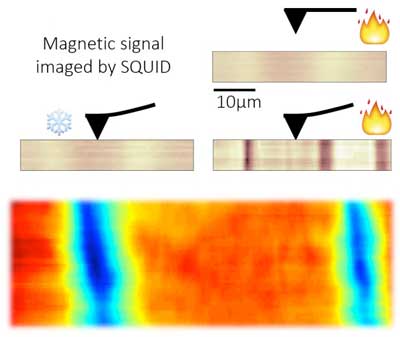| Dec 17, 2018 | |
Pressure tuned magnetism paves the way for novel electronic devices(Nanowerk News) Advances in the technology of material growth allow fabricating sandwiches of materials with atomic precision. The interface between the two materials can sometimes exhibit physical phenomena which do not exist in both parent materials. For example, a magnetic interface found between two non-magnetic materials. |
|
| A new discovery, published in Nature Physics ("Strain-tunable magnetism at oxide domain walls"), shows a new way of controlling this emergent magnetism which may be the basis for new types of magnetic electronic devices. | |
 |
|
| Sensitive magnetic imaging detects strain tunable magnetism. (Image: Kalisky Lab) | |
| Using very sensitive magnetic probes, an international team of researchers led by Prof. Beena Kalisky, of Bar-Ilan University's (BIU) Department of Physics and Institute of Nanotechnology and Advanced Materials (BINA) and Prof. Nini Pryds, of Technical University of Denmark's (DTU) Department of Energy, has found surprising evidence that magnetism emerging at the interfaces between non-magnetic oxide layers can be easily tuned by exerting tiny mechanical forces. The study was the fruit of the collaborative work done by the two PhD students Yiftach Frenkel (BINA) and Dennis Christensen (DTU) with additional researchers from BIU (Israel), DTU (Denmark) and Stanford (USA). | |
| Magnetism already plays a central role in storing the increasing amount of data produced by humanity. Much of our data storage today is based on tiny magnets crammed into our memory drive. One of the promising means in the race to improve memory, in terms of quantity and speed, is the use of smaller magnets. | |
| Until today the size of memory cells can be as small as a few tens of nanometers -- almost a millionth of the width of a strand of hair! Further reduction in size is challenging in three main respects: the stability of the magnetic cell, the ability to read it, and the ability to write into it without affecting its neighboring cells. This recent discovery provides a new and unexpected handle to control magnetism, thus enabling denser magnetic memory. | |
| These oxide interfaces combine a number of interesting physical phenomena, such as two-dimensional conductance and superconductivity. | |
| "Coexistence of physical phenomena is fascinating because they do not always go hand in hand. Magnetism and superconductivity, for example, are not expected to coexist," says Kalisky. "The magnetism we saw did not extend throughout the material but appeared in well-defined areas dominated by the structure of the materials. Surprisingly, we discovered that the strength of magnetism can be controlled by applying pressure to the material". | |
| Coexistence between magnetism and conductivity has great technological potential. For example, magnetic fields can affect the current flow in certain materials and, by manipulating magnetism, we can control the electrical behavior of electronic devices. An entire field called Spintronics is dedicated to this subject. The discovery that tiny mechanical pressures can effectively tune the emerging magnetism at the studied interfaces opens new and unexpected routes for developing novel oxide-based spintronic devices. |
| Source: Bar-Ilan University | |
|
Subscribe to a free copy of one of our daily Nanowerk Newsletter Email Digests with a compilation of all of the day's news. |
